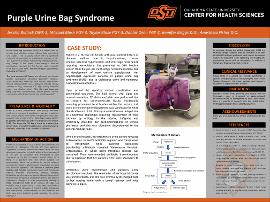| dc.contributor.author | Blalock, Jessica | |
| dc.contributor.author | Blose, Michael | |
| dc.contributor.author | Blose, Taylor | |
| dc.contributor.author | Osen, Daelor | |
| dc.contributor.author | Briggs, Jennifer | |
| dc.contributor.author | Fisher, Anastasia | |
| dc.date.accessioned | 2023-11-02T20:45:58Z | |
| dc.date.available | 2023-11-02T20:45:58Z | |
| dc.date.issued | 2023-02-17 | |
| dc.identifier | ouhd_Blalock_purpleurinebagsyndrome_2023 | |
| dc.identifier.citation | Blalock, J., Blose, M., Blose, T., Osen, D., Briggs, J., and Fisher, A. (2023, February 17). Purple urine bag syndrome. Poster presented at Research Week, Oklahoma State University Center for Health Sciences, Tulsa, Ok. | |
| dc.identifier.uri | https://hdl.handle.net/11244/339904 | |
| dc.description.abstract | Background: Purple urine bag syndrome (PUBS) is a rare complication of urinary tract infection in the setting of indwelling catheters, leading to purple discoloration of urine and tubing. Reported prevalence varies in the literature with poorly described incidence and management recommendations. It is noted to be associated with bedbound, constipated patients and history of end stage renal disease. We present a classic case of this unusual, but distinct finding. Case Presentation: 74 year old female with past medical history of type 2 diabetes mellitus, hypothyroidism, chronic anemia, essential hypertension, and end stage renal failure on hemodialysis presents from dialysis by nephrologist request for evaluation due to purple urine discoloration. Her urinary catheter was exchanged, and preliminary urine culture demonstrated Enterococcus infection. Final sensitivities revealed vancomyin resistant enterococcus. Her antimicrobial regimen was empirically started as cefepime and advanced to vancomycin upon preliminary results. Infectious disease was consulted upon final sensitivity result with recommendation to discontinue antibiotics, presuming colonization rather than acute infection. She was placed on a bowel regimen and did have restoration of normal yellow urine prior to discharge. The remainder of her hospital course was uneventful and she was discharged back to the nursing home. Discussion: In patients with indwelling foley and chronic urinary tract infection, PUBS may arise. This is thought to be due to gastrointestinal metabolism of tryptophan by gut bacteria. Tryptophan conjugates undergo oxidation within the urine, leading to indigo and indirubicin pigmentation. This produces the consequential and notable urinary discoloration. Constipation allows for bacterial overgrowth, and renal failure decreases clearance of these metabolites Together this leads to predisposition to purple urine. In summary, despite the striking appearance PUBS is a relatively benign condition with the limitation of no well-established treatment guidelines. Most sources recommend multimodal treatment with addressing the predisposing factors such as treating constipation in addition to changing of foley bag materials regularly. | |
| dc.format | application/pdf | |
| dc.language | en_US | |
| dc.publisher | Oklahoma State University Center for Health Sciences | |
| dc.rights | The author(s) retain the copyright or have the right to deposit the item giving the Oklahoma State University Library a limited, non-exclusive right to share this material in its institutional repository. Contact Digital Resources and Discovery Services at lib-dls@okstate.edu or 405-744-9161 for the permission policy on the use, reproduction or distribution of this material. | |
| dc.title | Purple urine bag syndrome | |
| osu.filename | ouhd_Blalock_purpleurinebagsyndrome_2023.pdf | |
| dc.type.genre | Presentation | |
| dc.type.material | Text | |
| dc.subject.keywords | catheter | |
| dc.subject.keywords | constipation | |
| dc.subject.keywords | UTI | |
